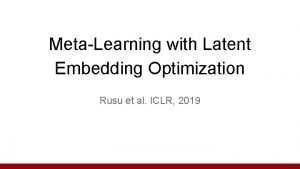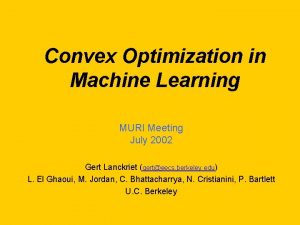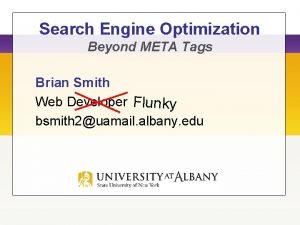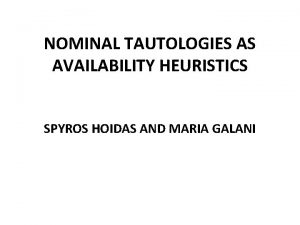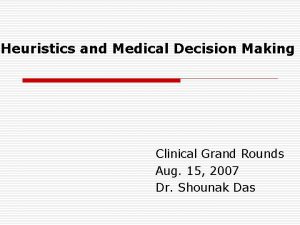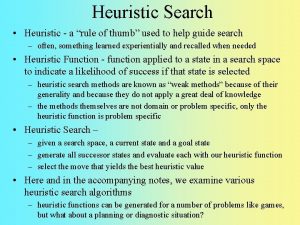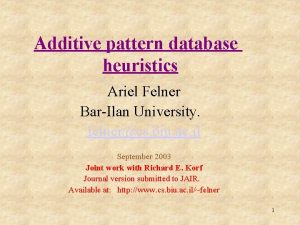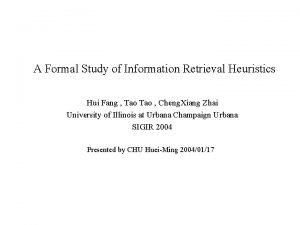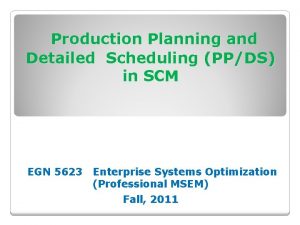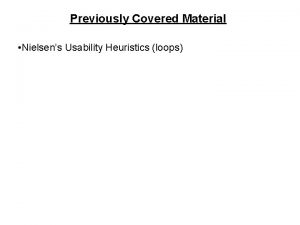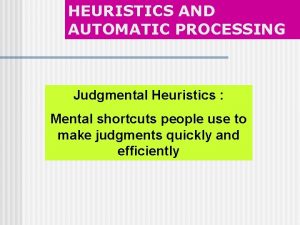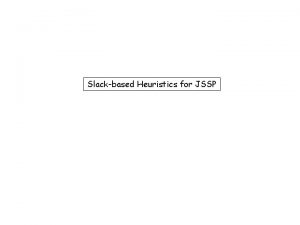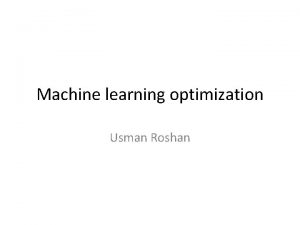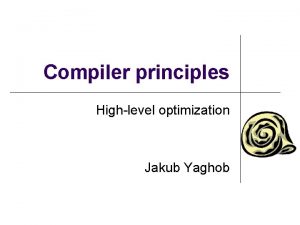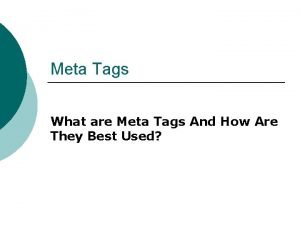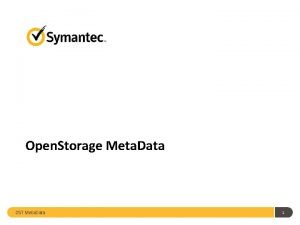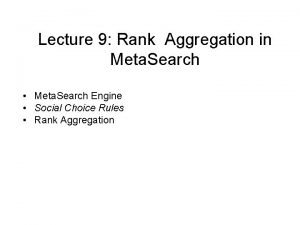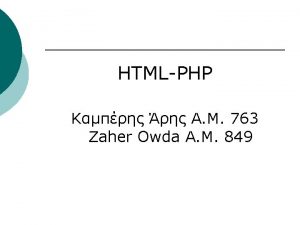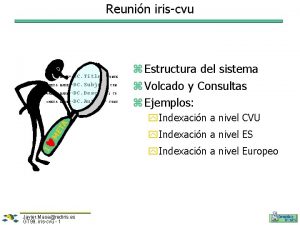Meta Optimization Improving Compiler Heuristics with Machine Learning


































- Slides: 34

Meta Optimization Improving Compiler Heuristics with Machine Learning Mark Stephenson, Una-May O’Reilly, Martin, and Saman Amarasinghe MIT Computer Architecture Group Presented by Utku Aydonat

Motivation • Compiler writers are faced with many challenges: – Many compiler problems are NP-hard – Modern architectures are inextricably complex • Simple models can’t capture architecture intricacies – Micro-architectures change quickly

Motivation • Heuristics alleviate complexity woes – Find good approximate solutions for a large class of applications – Find solutions quickly • Unfortunately… – They require a lot of trial-and-error tweaking to achieve suitable performance – Fine tuning is a tedious process

Priority Functions • A single priority or cost function often dictates the efficacy of a heuristic • Priority Function: A function of the factors that affect a given problem • Priority functions rank the options available to a compiler heuristic

Priority Functions • Graph coloring register allocation (selecting nodes to spill) • List scheduling (identifying instructions in worklist to schedule first) • Hyperblock formation (selecting paths to include) • Data Prefetching (inserting prefetch instructions)

List Scheduling

Machine Learning • They propose using machine learning techniques to automatically search the priority function space – Feedback directed optimization – Find a function that works well for a broad range of applications – Needs to be applied only once

Generic Programming • Modeled after Darwinism (Survival of the Fittest). • Parse trees of operators and operands describe the potential priority functions. • A population is a collection of parse trees for one generation. • After testing, several members of the population are selected for reproduction via crossover, which swaps a random node from each of 2 parse trees. • Other parse trees are selected for mutation, in which a random node is replaced by a random expression.

Generic Programming

Genetic Programming Create initial population (initial solutions) Evaluation Selection Generations < Limit? END Generation of variants (mutation and crossover)

Generic Programming • The system selects the smaller of several expressions that are equally fit so that the parse trees do not grow exponentially. • Tournament selection is used repeatedly to select parse trees for crossover. – Choose N expressions at random from the population and select the one with the highest fitness. • Dynamic subset selection (DSS) is used to reduce fitness evaluations to achieve suitable solution.

Meta Optimization • Just as with Natural Selection, the fittest individuals are more likely to survive and reproduce. • Expressions creating fastest code are the fittest. • Create 399 random expressions based on parameters. • It also seeded with the compiler writer’s best guesses

Meta Optimization

Case Study I: Hyperblock Formation • Find predictable regions of control flow • Prioritize paths based on several characteristics – The priority function we want to optimize • Add paths to hyperblock in priority order

Hyperblock Formation

Case Study I: IMPACT’s Function Favor frequently Executed paths Penalize paths with hazards Favor short paths Favor parallel paths

Hyperblock Formation • What are the important characteristic of a hyperblock formation priority function? • IMPACT uses four characteristics • Extract all the characteristics you can think of and have a machine learning algorithm find the priority function

Hyperblock Formation x 1 Maximum ops over paths x 2 Dependence height x 3 Number of paths x 4 Number of operations x 5 Does path have subroutine calls? x 6 Number of branches x 7 Does path have unsafe calls? x 8 Path execution ratio x 9 Does path have pointer derefs? x 10 Average ops executed in path x 11 Issue width of processor x 12 Average predictability of branches in path … x. N Predictability product of branches in path

0 1 1. 23 1. 54 1. 5 Average mpeg 2 dec toast rawdaudio rawcaudio huff_enc Train data set huff_dec g 721 decode g 721 encode 129. compress Speedup Hyperblock Results Compiler Specialization 3. 5 Alternate data set 3 2. 5 2 0. 5

Hyperblock Results A General Purpose Priority Function

Cross Validation Testing General Purpose Applicability

Case Study II: Register Allocation A General Purpose Priority Function

Register Allocation Results Cross Validation

Case Study III: Prefetching A General Purpose Priority Function

Prefecthing Results Cross Validation

Conclusion • Machine learning techniques can identify effective priority functions • ‘Proof of concept’ by evolving three well known priority functions • Human cycles v. computer cycles

My Conclusions • Heuristics to improve heuristics – How to choose population size, mutation rate, tournament size? • Does it guarantee better results? • Requires a lot of experiments for the results to converge. – Do we have that opportunity? • It is very effective for optimizing a specific application space.

Thank you!

GP Hyperblock Solutions General Purpose (add Intron that doesn’t affect (sub (mul exec_ratio_mean 0. 8720) 0. 9400) solution (mul 0. 4762 (cmul (not has_pointer_deref) (mul 0. 6727 num_paths) (mul 1. 1609 (add (sub (mul (div num_ops dependence_height) 10. 8240) exec_ratio) (sub (mul (cmul has_unsafe_jsr predict_product_mean 0. 9838) (sub 1. 1039 num_ops_max)) (sub (mul dependence_height_mean num_branches_max) num_paths)))))))

GP Hyperblock Solutions General Purpose (add (sub (mul exec_ratio_mean 0. 8720) 0. 9400) (mul 0. 4762 (cmul (not has_pointer_deref) Favor paths that don’t (mul 0. 6727 num_paths) have pointer dereferences (mul 1. 1609 (add (sub (mul (div num_ops dependence_height) 10. 8240) exec_ratio) (sub (mul (cmul has_unsafe_jsr predict_product_mean 0. 9838) (sub 1. 1039 num_ops_max)) (sub (mul dependence_height_mean num_branches_max) num_paths)))))))

GP Hyperblock Solutions General Purpose (add (sub (mul exec_ratio_mean 0. 8720) 0. 9400) (mul 0. 4762 Favor highly parallel (fat) (cmul (not has_pointer_deref) (mul 0. 6727 num_paths) paths (mul 1. 1609 (add (sub (mul (div num_ops dependence_height) 10. 8240) exec_ratio) (sub (mul (cmul has_unsafe_jsr predict_product_mean 0. 9838) (sub 1. 1039 num_ops_max)) (sub (mul dependence_height_mean num_branches_max) num_paths)))))))

GP Hyperblock Solutions General Purpose (add (sub (mul exec_ratio_mean 0. 8720) 0. 9400) If a path calls a (mul 0. 4762 subroutine that may have (cmul (not has_pointer_deref) side effects, penalize it (mul 0. 6727 num_paths) (mul 1. 1609 (add (sub (mul (div num_ops dependence_height) 10. 8240) exec_ratio) (sub (mul (cmul has_unsafe_jsr predict_product_mean 0. 9838) (sub 1. 1039 num_ops_max)) (sub (mul dependence_height_mean num_branches_max) num_paths)))))))

Case Study I: IMPACT’s Algorithm A 4 k 24 k B 10 Path C 4 k 22 k 2 k E D 2 k 10 25 F ops dep pr A-B-D-F-G ~0 1. 0 13 4 ~0 A-B-F-G 0. 14 1. 0 10 4 0. 21 A-C-F-G 0. 79 1. 0 9 2 1. 44 A-C-E-F-G 0. 07 0. 25 13 5 0. 02 A-C-E-G 0. 25 11 3 ~0 28 k G exec haz 28 k ~0

Case Study I: IMPACT’s Algorithm A 4 k 24 k B 10 Path C 4 k 22 k 2 k E D 2 k 10 25 F ops dep pr A-B-D-F-G ~0 1. 0 13 4 ~0 A-B-F-G 0. 14 1. 0 10 4 0. 21 A-C-F-G 0. 79 1. 0 9 2 1. 44 A-C-E-F-G 0. 07 0. 25 13 5 0. 02 A-C-E-G 0. 25 11 3 ~0 28 k G exec haz 28 k ~0
 Discuss about machine independent featuresof a loader
Discuss about machine independent featuresof a loader Latent embedding optimization
Latent embedding optimization Convex optimization in machine learning javatpoint
Convex optimization in machine learning javatpoint Meta sinclair
Meta sinclair Meta tags for search engine optimization
Meta tags for search engine optimization Yet another compiler compiler
Yet another compiler compiler Cross compiler in compiler design
Cross compiler in compiler design Improving own learning and performance examples
Improving own learning and performance examples Improving student learning one teacher at a time
Improving student learning one teacher at a time Improving student learning one teacher at a time
Improving student learning one teacher at a time Np - /availability-heuristics/
Np - /availability-heuristics/ Types of heuristics
Types of heuristics Best first search algorithm
Best first search algorithm Heuristics in arabic
Heuristics in arabic Pattern database heuristics
Pattern database heuristics A formal study of information retrieval heuristics
A formal study of information retrieval heuristics Shneiderman 8 golden rules
Shneiderman 8 golden rules Ppds heuristics
Ppds heuristics Heuristics
Heuristics Heuristics
Heuristics Object oriented design heuristics arthur riel pdf
Object oriented design heuristics arthur riel pdf Oo heuristics
Oo heuristics P ways
P ways Nielsens heuristics
Nielsens heuristics Pattern database heuristics
Pattern database heuristics Concept learning task in machine learning
Concept learning task in machine learning Analytical learning in machine learning
Analytical learning in machine learning Pac learning model in machine learning
Pac learning model in machine learning Machine learning t mitchell
Machine learning t mitchell Inductive and analytical learning in machine learning
Inductive and analytical learning in machine learning In analytical learning hypothesis fits
In analytical learning hypothesis fits Instance based learning in machine learning
Instance based learning in machine learning Inductive learning machine learning
Inductive learning machine learning First order rule learning in machine learning
First order rule learning in machine learning Eager learner vs lazy learner
Eager learner vs lazy learner

